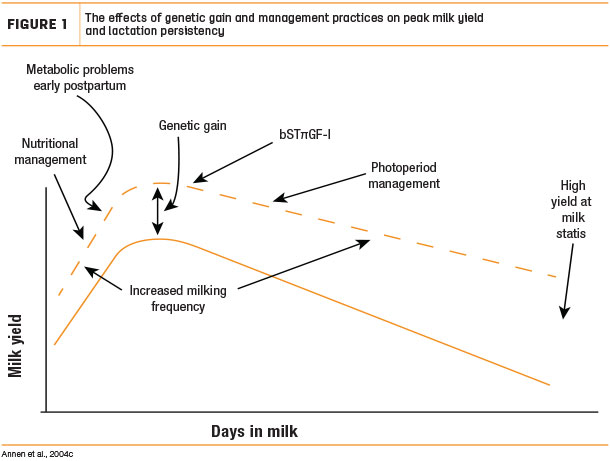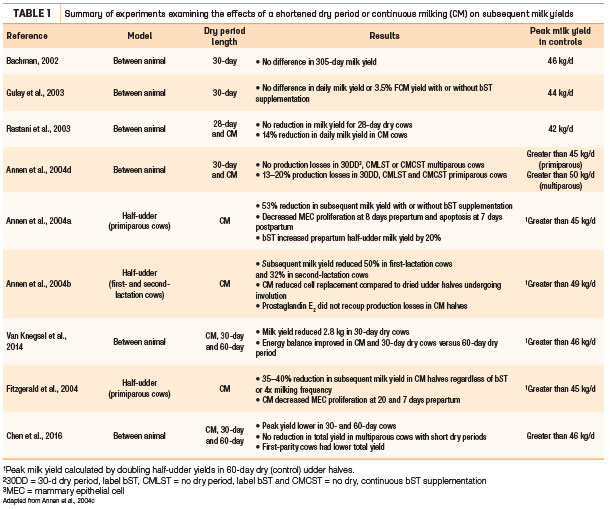The optimal dry period length between lactations in dairy cows has been debated since the early 1800s. During this time, some English farmers believed a two-month dry period was optimal, while others believed a two-week dry period was adequate.
More than a century later, during World War II, the 60-day dry period was adopted as the optimal dry period length for maximum milk yield and genetic progress during this time of food shortage.
Since its adoption, the 60-day dry period has been maintained as the dry period length that best maintains the balance between lost milk income during the dry period and production levels achieved in the subsequent lactation. Currently, a majority of U.S. dairies manage for a 60-day-or-longer dry period.
However, there have been many changes since adoption of the 60-day dry period that include an 11,000-pound increase in milk yield per lactation, a larger emphasis on profit, accelerated genetic progress through A.I. and embryo transfer, adoption of the TMR, increased milking frequency, altered photoperiod management and commercialization and adoption of bovine somatotropin. Such changes warrant a re-evaluation of the optimal dry period length in today’s high-producing dairy cow.
Opportunities for change in the dry period requirement
Increased production levels and improved persistency of lactation in today’s dairy cow provide new reasons to re-evaluate the optimal dry period length in dairy cows.
The first reason is increased milk yield at the time of dry-off (Figure 1). Many cows are producing more than 66 pounds per day at dry-off and have the potential to milk through the last 60 days of gestation at a profitable production level.

Additional days of lactation maximize income generated per cow per lactation and decrease the number of replacement animals needed to keep a dairy operating at desired cow number capacity. While high yields at dry-off provide an economical reason for modified dry periods, they also create a cow health and comfort reason for short or omitted dry periods.
High yields at dry-off result in extreme changes in metabolic and physiological state, which are complicated with dramatic diet changes. Such extremes result in the addition of a second transition period to the lactation cycle.
For example, the cow undergoes the discomfort of udder engorgement and involution during the early dry period combined with a diet change from a lactating ration to a far-off dry cow ration as the animal and mammary gland go from producing 66 pounds to zero pounds per day at dry-off.
Another reason to investigate modified dry periods in high-producing cows lies at the beginning of the lactation curve in the “traditional” transition period (three weeks prepartum to three weeks postpartum) when the stress of parturition, initiation of lactation and dramatic diet changes occur.
These two transition periods within 60 days of each other offer the cow a relatively short time period to adapt to several acute changes in metabolic and physiologic states and diets. Continuous milking may keep the animal adapted to lactation and associated diets and reduce the incidence of metabolic disorders as well as improve dry matter intake during this transition period.
The third and perhaps most important reason to re-evaluate optimal dry period length comes from new management technologies introduced since World War II that improve milk yield.
Some of these management technologies, including increased milking frequency, bovine somatotropin and photoperiod management, are known to increase milk yield and therefore may address the issue of reduced mammary functionality in mammary epithelial cells without a rest period between lactations.
Recent research on modified dry periods
Research on modified dry periods has consistently demonstrated first-parity animals need an eight-week dry period and that milk yield in these animals is considerably lower in the next lactation without it. In 1982, researchers determined as age at calving in the lactation before a shortened dry period increased from 24 to 83 months, the dry period requirement for optimal milk yield decreased from 65 to 23 days.
Multiple authors have evaluated modified dry periods and reported a short dry period of 30 days did not result in a reduced milk yield in multiparous cows (Table 1).

In 2016, researchers indicated dry period length altered the shape of the lactation curve but did not affect overall milk yield in multiparous cows. Reducing the dry period length shifts a portion of the milk yield from the postpartum to the prepartum period when feed intake easily matches milk yield.
This improves energy status of animals in early lactation, and a 2014 study showed feeding a more glucogenic diet in early lactation would improve energy balance further in cows with reduced dry period lengths.
In 2016 and 2017, researchers utilized prepartum and postpartum milk yields to estimate milk yields of cows with modified dry periods and also reported a short dry period reduced calving interval by 18 days. It was estimated that the milk yield reduction in multiparous cows with short dry periods was 2.2 pounds per day and did not change over multiple lactations.
Effects of modified dry periods on the transition period
Reduced dry matter intake during the final weeks of gestation occurs as nutrient demands for conceptus growth and the onset of lactation increase, creating a state of negative energy and possibly protein balance by the last week of gestation and during early lactation.
Negative energy and protein balance result in mobilization of body reserves to meet nutrient demands for pregnancy and lactation and predispose the animal to metabolic diseases. Improvements in dry matter intake during this period would improve energy/protein balance, thus reducing health risks.
Continuous milking or 30-day dry periods have been suggested to improve energy balance. Improved bodyweight, decreased plasma non-esterified fatty acid levels, increased blood glucose levels and enhanced milk protein synthesis are all indicators of improved energetic status and have been demonstrated in cows given modified dry periods. Other studies on modified dry periods have reported improved dry matter intake.
Cows dry 30 days tended to have increased dry matter intake and lost less body condition than 60-day dry cows.
Data from 2003 demonstrated a 21 percent greater dry matter intake in 28-day dry cows and 30 percent greater dry matter intake in continuous milking cows compared to 56-day dry cows. Dry matter intake was also measured in half-udder studies conducted in 2004. As long as the continuous milking half was milking, cows were fed a high-energy lactating diet.
Cows that spontaneously dried in the continuous milking half before parturition were switched to a close-up, dry-cow diet (moderate-energy) until parturition. This elimination or reduction in diet changes resulted in dramatic improvements in dry matter intake. In 2011, researchers showed short dry periods reduced the incidence of mild ketosis in herds. In 2014, it was also demonstrated that short dry period management improved peripartum ruminal efficiency and adaptation in transition dairy cows.
Take-away
Primiparous animals need an eight-week dry period. This parity sensitivity to dry period length is likely the result of continued mammary development between the first and second lactations. Production losses in multiparous animals have varied with either no production losses reported or a 2-pounds-per-day loss in production.
Short dry periods are associated with increased feed intake, improved ruminal function, reduced incidence of mild ketosis, improved body condition and shorter calving intervals. We do not yet know if reproductive performance is benefited by the improved body condition and metabolic status of animals with short dry periods. ![]()
References omitted but are available upon request.
Ehrin Annen Dawson is with Threemile Canyon Farms, Boardman, Oregon.

-
Robert J. Collier
- University of Arizona
- Tucson, Arizona






